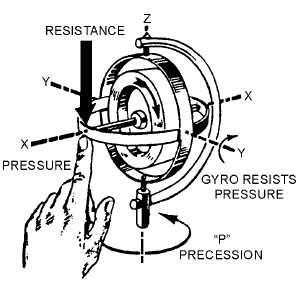3-9
without disturbing the plane of rotation of the rotor. This condition exists because the force that is applied
through the supporting frame, acting through the center of gravity produces no torque on the gyro rotor.
ONLY THOSE FORCES TENDING TO TILT THE GYRO WHEEL ITSELF WILL CAUSE
PRECESSION.
Let's consider further the important characteristic of gyroscopic precession. For a given amount of
force, the rate of precession of a gyro is governed by the weight, shape, and speed of the rotor. These
factors are the same as those that determine the rigidity of a gyro. Therefore, there is a definite
relationship between the rigidity of a gyro and the rate at which a given force will cause it to precess. The
greater the rigidity of a gyro, the more difficult it is to cause precession, and the less precession there will
be for a given force.
A gyro will resist any force that attempts to change the direction of its spin axis. However, it will
move (precess) in response to such force; NOT in the direction of the applied force, but at right angles to
it.
The direction a gyro will precess also depends on the direction the gyro is spinning. Precession is
actually the result of two forces: angular momentum (spinning force) and the applied force (torque). The
direction of precession is always offset from the direction of the applied force. The offset is always in the
direction of rotor spin.
For example, when a force is applied upward on the inner gimbal, as shown in figure 3-8, the force
may be visualized as applied in an arc about axis Y-Y. This applied force is opposed by the resistance of
gyroscopic inertia, preventing the gyro from rotating about axis Y-Y. With the rotor spinning clockwise,
the precession will take place 90º clockwise from the point of applied force. The gyro precesses about
axis Z-Z in the direction of the arrow "P".
Figure 3-8.—Force applied to a gyro.
The motions of a gyroscope can be analyzed according to three basic quantities:
1. SPIN (the angular velocity of the gyro rotor).
2. TORQUE (the rotary motion applied to change the direction of the rotor axis).


